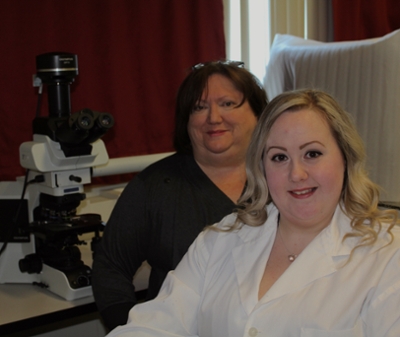
A shock to the system
Ongoing research at the CoM could potentially help to repair demyelinated central nerves
By Marg SheridanElectrically stimulating nerves that have lost myelin can help repair the nerve by altering the immune environment according to research at the College of Medicine.
A recent paper published by Dr. Valerie Verge, Director of the Cameco MS Neuroscience Research Center, and Dr. Nikki McLean, has looked at whether the stimulation can change the immune environment from inflammatory to pro-repair. The research can have broad implications in the treatment of diseases that damage or remove the myelin sheaths protecting nerves, which includes multiple sclerosis (MS).
“In the nervous system you have long cables called axons that extend from the nerve cell and helps it to communicate to the next nerve cell, or the tissue it connects with,” explained Verge. “Electro-chemical signals are relayed along the axon, and in order to do this efficiently it’s wrapped in, and insulated by a fatty substance called myelin, just like insulation on an electrical wire; and it’s the myelin that is inappropriately targeted for destruction in demyelinating disease such as MS. “When you remove that myelin you essentially short circuit the (nerve), just like a frayed electrical wire that rats chewed away the outer coating on.”
“We wanted a way to repair the lost myelin more rapidly, not only to regain lost function, but also because we risk losing the axon when the myelin is not there to protect it.”
When the myelin is attacked and removed, there is a strong immune reaction that can be very damaging. The immune cells, called macrophages, that come in as a result of the damaged myelin are the focus of the current research because they can take on properties that can either contribute to a potentially harmful pro-inflammatory environment, or they can take on pro-repair properties that help improve repair.
And the research reflects that the team has found a way to ensure that the nerves take on that beneficial pro-repair property.
This is an approach that the Verge lab had been using in collaboration with colleagues at the universities of Alberta, Calgary and Johns Hopkins to help nerves regenerate after traumatic injury.
“While the initial research (demonstrated) that brief one hour electric stimulation can help to speed nerve regeneration, is now in clinical trials to help treat patients who have suffered from peripheral nerve injuries such as occurs in carpal tunnel syndrome,” Verge continued. “We hoped that it could also help nerves that had their myelin damaged repair better.”
Several years ago, McLean, then a doctoral candidate, began investigating this. Not only did electrical stimulation of the nerves which had myelin damage help replace the lost myelin more efficiently compared to those nerves that were not stimulated, but the macrophages appeared to do their job of clearing away the damaged myelin far more effectively, a process that needs to occur before new myelin can wrap around the axon.
“It was as if the cells had been turned into super macrophages,” Verge explained.
The hope, Verge explains, is that they’ll be able to translate some of the results from the studies involving the peripheral nerves to repairing damaged central nerves.
“We can often apply strategies involved in repairing one part of the nervous system to help out in another,” Verge stressed. “If you tease them out you can start thinking about which aspects may help in diseases like MS, which may not have the same start point, but may have some commonalities in their repair processes aimed at helping the person return to a high functioning state again.”
So while the studies published thus far from the Verge lab have focused on myelin damage in peripheral nerves that lie outside the central nervous system, they are in the process of being adapted for myelin damage in the central nervous system – the brain and spinal cord.
“We’ve created a new model where we can still directly stimulate the nerve,” she continued. “But now we look into areas of the central nervous system that we have focally demyelinated to see if that increased neuronal activity helps it as well with respect to not only myelin repair, but also transitioning the immune cells from a pro-inflammatory to a pro-repair state.”
The research could help with the treatment of a number of diseases that can cause demyelination, including Guillain-Barré syndrome, but has a significant bearing on Saskatchewan because the province has one of the highest incidences of MS in the world.
In ongoing collaborative work, the team is working with Dr. Gillian Muir, head of veterinary biomedical sciences, they are now using both direct nerve stimulation and a new strategy to cause nerve cells to fire without being invasive.
This research was possible thanks to funding awarded to the lab from the MS Society of Canada and Canadian Institutes of Health Research (CIHR).
